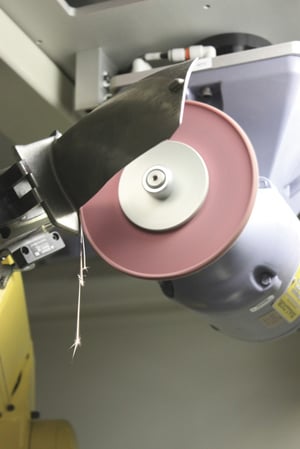 Many metal parts must be deburred before being put to use, but not all finishing applications are created equal. When determining the most efficient way of deburring, there are several factors to look at including the quantity of parts you are finishing as well as the consistency needed from part to part. In the past few years larger shops have been implementing robotic deburring, and smaller companies have been researching the technology.
Many metal parts must be deburred before being put to use, but not all finishing applications are created equal. When determining the most efficient way of deburring, there are several factors to look at including the quantity of parts you are finishing as well as the consistency needed from part to part. In the past few years larger shops have been implementing robotic deburring, and smaller companies have been researching the technology.
As for robotic deburring, one early adopter is the Aerospace industry.
Jet engines are high performance machines and a burr, even if it is only one thousandths of an inch, can have expensive and dangerous consequences. Each turbine blade within the engine must be manufactured to tight tolerances. These blades routinely operate under high stress, and edge breaking is a method used to strengthen the components. When a micro radius is put on a part to spread the stress away from 90 degree angles, great care must be taken to retain its original geometry. Failing to do so can affect the aerodynamics of the plane and reduce efficiency.
This is an example of where robotics excel. Turbine blades are made and deburred in a volume that makes sense to take the time and spend the money to implement a machine with precision deburring abilities. AV&R Aerospace is doing an excellent job creating robotic cells specifically for this application.
In the same industry, when smaller parts or components that are not produced at a high volume are being finished, hand deburring is still going strong.
Here’s why:
Programming compliance requires tremendous sophistication, and might be overkill for general deburring.
It’s common to employ robotics to complete work like machining parts because every motion can be calculated and programmed. But no two burrs are exactly alike and tiny differences make deburring and edge breaking each individual part subtly different. Programing compliance in robotics is a task that allows for very consistent finishing and tight tolerances. For jobs that don’t require such tight tolerances part after part, performing manual deburring is a time tested method. Skilled workers account for inconsistencies with “feel.” As the operator pushes on the part, force is exerted back on the tool and that force is part of what guides the process to perfect deburring and edge breaking.
Deburring by hand is faster when working on custom or low volume orders.
Programing a deburring cell to finish a part takes a good amount of time. In addition, to get the process perfect, you will need to run tests on a few spare parts. If it’s low volume runs, this will take longer than manually deburring. In these situations, it’s more practical for human operators to complete the task.
Smaller shops just don’t have the budget.
As of now, implementing robotics takes a chunk of change. Companies with larger capital are benefiting from robotics, but as this technology becomes more affordable, smaller businesses will begin to invest in this machinery. As of now, we see the majority of small shops deburring with human operators.
Robotics are constantly evolving and improving. They have earned their existing place in manufacturing processes that can be accomplished using repetitive motions for high volume parts. But until robotics become attainable for smaller shops and custom parts, manual deburring is still a very viable option.
Whether you stick with tried and true manual deburring or implement robotic solutions, Rex-Cut has you covered with cotton fiber abrasives that can both deburr and finish parts using one tool.